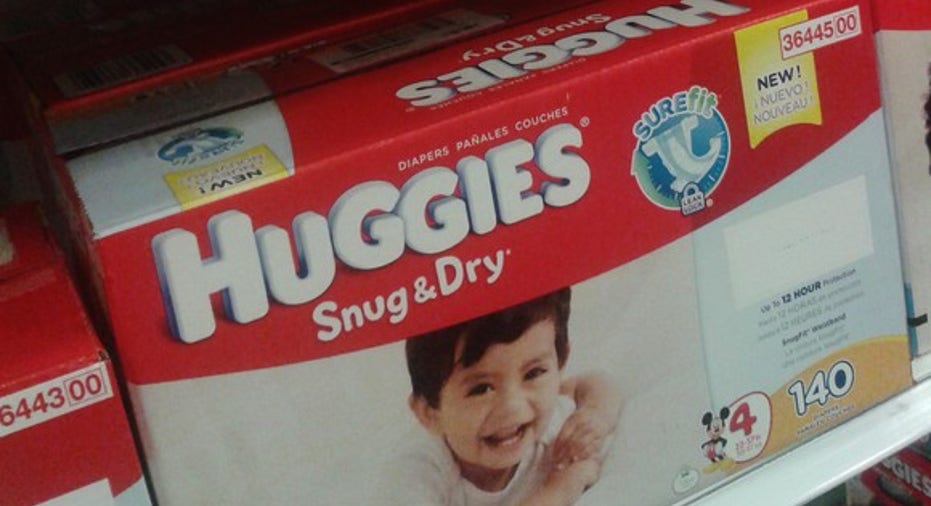Huggies Enters Parenting Minefield, Pushing to Pricier Pull-Ups

The company behind Huggies is wading into the messy debate over when to start toilet training.
Kimberly-Clark (NYSE:KMB) has benefitted as more parents opt for Huggies Pull-Ups disposable training pants over less-expensive diapers. Sales of Pull-Ups, which absorb wetness like diapers but can be pulled on or off like underpants, grew by double-digits in 2015 and again in 2016, offsetting a decline in diaper sales.
A pack of 74 Pull-Ups costs $24.99 at Target.com (NYSE:TGT), while a box of 140 Huggies Snug & Dry diapers goes for the same price. In addition to helping the company's bottom line, executives said parents' willingness to pay for Pull-Ups signals an economy on the mend.
It is a trend that Kimberly-Clark would like to see continue.
During a call with analysts last month, its operations chief, Michael Hsu, said Pull-Ups brand managers were working to promote earlier potty training.
"There's a strategy on their part to say, 'Hey, we want children to start training earlier and we want them to stay more consistent in the training pant,'" he said.
Stepping into the whirlwind of perspectives by parents and pundits is a risky move for Dallas-based Kimberly-Clark. How to raise toddlers prompts endless debate online, much of it revolving around when toilet training should start.
Most every major parenting and medical website has reams of information, from essays by pediatricians to interactive quizzes, aimed at helping parents decide when to start and which methods are best. Parents weigh in on blogs and message boards with their own opinions.
For instance, thousands of commenters have posted on parenting site babycenter.com's various potty-training threads, which included everything form a debate over whether to reward children for using the toilet to a mom who experimented with both diapers and training pants for her children and ultimately "just made them run around the house in real underwear."
Some child-care experts say that training pants, because they are so similar to diapers, don't encourage toilet use.
"No kid will use a trainer like underwear, which is what marketers want people to think," said Sarah Grover, a potty-training consultant in Chicago. "If a child can pee and poop in there and not get wet, that's not potty training."
Huggies in 2016 started a marketing campaign aimed at teaching parents to recognize when children are ready for potty training, and training pants. It also enlisted a child development expert who authors posts on the company's web site giving advice such as, "Diapers are for babies. Pull-Ups are for big kids," and discouraging parents from returning to diapers once they have begun using training pants.
But it avoids specifying an age when that should begin, said Arist Mastorides, head of Kimberly-Clark's North American childcare business.
"We would never tell mom implicitly when to start," he said. "It's a hard journey and it's messy and time-consuming. We're trying to help educate parents on the signs of readiness to help moms get comfortable with training."
Competition in training pants has been intensifying between Huggies and its chief rival, Procter & Gamble Co.'s Pampers (NYSE:PG), which was late to the game but has been gaining customers.
Like Kimberly-Clark, it charges more for training pants than traditional diapers: An 80-pack of Pampers Easy-Ups costs $24.99, similar in price with a box of 104 Pampers Baby Dry diapers.
P&G is pushing hard to catch up with Kimberly-Clark in a rivalry that led to a dispute over advertising.
P&G in January agreed to modify its Easy-Ups advertising after the National Advertising Division agreed with a Kimberly-Clark complaint that it was misleading. P&G agreed to stop saying, "You'll see drier nights," and to change the wording of the claim, "doesn't leak like ordinary training pants."
But P&G said it would appeal the regulatory body's decision that it stop using "the best way to potty-train" and "the easiest way to underwear," arguing the phrases constitute so-called puffery, or vague and subjective advertising claims.
Pampers Easy-Ups had 23% of the U.S. training-pants market in December, up from 14% in July, according to Nielsen data supplied by the company. Huggies, still the dominant player, saw its share drop to 53% from 62% in that time.
Overall, U.S. sales of training pants rose 5.3% to $1 billion in the 52-week-period ending Jan. 28, according to Nielsen. Diaper sales fell 4.4% to $3.9 billion during that period, the first decline in at least four years.
P&G said it doesn't encourage parents to start potty-training earlier. "We recognize every toddler and every family is unique, and parents really are in the best position to determine when and how to embark on potty training for their little ones," a P&G spokeswoman said in an email.
The Cincinnati company does, however, take issue with the idea that training pants are no different than diapers when it comes to potty training. Toddlers, for instance, lie down during a diaper change but can aid in changing in and out of training pants and are generally standing during the process.
Training pants are built differently than diapers and cost more. Some come with more bells and whistles. For example, Huggies Cool Alert Pull-Ups get cold when wet, alerting the child to an accident.
Jingjing Sun in Seattle did exhaustive research when her son, now 4 1/2 , neared potty-training age, trying training pants as well as cloth diapers. She uses training pants for her 2-year-old daughter at night, but now that Ms. Sun has two children and a more hectic life, she doesn't spend as much time weighing the pros and cons of different types of diapers.
"Eventually I just said, 'I don't care that much,'" Ms. Sun said.



















